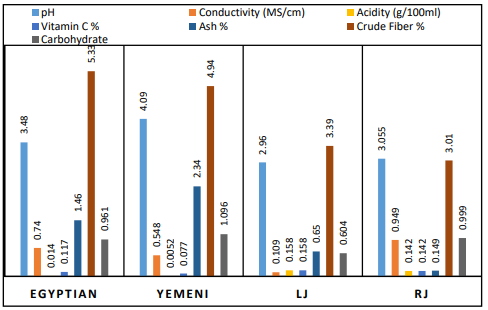Quantitative Evaluation of Nutritional fact of Pomegranate Fruit Extract and Comparison with Two Pomegranate Packed Juice Samples
Keywords:
Pomegranate fruit extract, pomegranate packed juice, physico-chemical analysis, nutrition fact, comparisonAbstract
The aim of the present study was to analyze and comparison of various nutritional fact of pomegranate juice extract and pomegranate packed juice sample. We have studied various physico-chemical parameters and found result such as pH (2.96 – 4.09), conductivity (0.109 – 0.949 MS/cm), TSS (13 – 17.5 %), acidity, (0.0052 – 0.158 g/100ml), vitamin C (0.077 – 0.158%), crude fiber (3.01 – 5.33 %), sodium (15.9 – 21.8 mg/100ml), potassium (17.89 – 90.5 mg/100ml), calcium (3.2 – 81.6 mg/100ml), iron (0.088 – 0.767 mg/100ml) etc. We used very cost effective different chemical and instrumental method for analysis. Study shows that, the pomegranate fruit juice extract was found good amount and significant values of various nutrition values less acidic, TSS, crude fiber, ash. Minerals demonstrate various health benefits and result obtained our study shows that, potassium, magnesium, calcium and iron are significant amount in fruit juice extract (diluted). While sodium found lower in fruit juice sample than packed juice. Lower value of sodium is good for health.
References
F. Khoshnam , A. Tabatabaeefar, M. G. Varnamkhasti, A. M. Borghei, “Mass modeling of pomegranate (Punica granatum L.) fruit with some physical characteristics,” Scientia Horticulturae , vol. 114, pp. 21–26, 2007. D oi: 10.1016/j.scienta.2007.05.008
A. Sarkhosh, Z. Zamani, M. Fatahi, “A review on medicinal characteristics of pomegranate (Punica granatum L.),” Journal Of Medicinal Plants, vol. 6, Issue 22, pp.13-24, 2006.
V. T. Jadhav, J. Sharma, “Pomegranate cultivation is very promising,” Indian Horticulture, Vol. 52, pp. 30–31, 2007.
A. Tehranifar, M. Zarei, B. Esfanidiyari, Z. Nemati, “Physico-chemical properties and antioxidant activity of pomegranate fruit (Punica granatum L.) of different cultivars grown in Iran,” Hortic. Env. Biotech. , Vol. 51, pp. 573–579, 2010.
M. Viuda-Martos, J. Fernandez-Lopez, J.A. Perez-Alvarez, “Pomegranate and its many functional components as related to human health: A Review,” Comp. Rev. Food Sci. Food Saf. Vol. 9, pp. 635–654, 2010.
M. G. Miguel, M. A. Neves, M. D. Antunes, “Pomegranate (Punica granatum L.): A medicinal plant with myriad biological properties– A short review,” J. Med. Plant Res. Vol. 4, Issue 25, pp. 2836–2847, 2010.
A. F. Olaniyi, L.O. Umezuruike, I.T. Karen, “Chemical and Phytochemical Properties and Antioxidant Activities of Three Pomegranate Cultivars Grown in South Africa,” Food Bioprocess Technol, vol. 5, Issue 7, pp. 2934-2940, 2010.
M. Ozgen, C. Durgac, S. Serce, C. Kaya, “Chemical and antioxidant properties of pomegranate cultivars grown in the Mediterranean region of Turkey”, Food Chem, vol. 111, pp. 703-706, 2008. Doi: 10.1016/j.foodchem.2008.04.043
M.S. Khodade, K.N. Wavhal, P.N. Kale, “Physicochemical changes during growth and development of pomegranate,” Indian J. Hortic. Vol. 47 , pp. 21-27, 1990.
R. Chandra, A.S. Lohakare, D. B. Karuppannan, A. Maity, N. Vikram Singh, V. T. Jadhav, “Variability studies of physico-chemical properties of pomegranate (Punica granatum L.) using a scoring technique,” Fruits, vol. 68, pp. 135–146, 2013.
J. Gadže, M. Prli?, M. Buli?, M. Leko, M. Barbari?, D. Vego, M. Raguž, “Physical and chemical characteristics and sensory evaluation of pomegranate fruit of (Punica granatum L.)” cv. ”Glavaš”, Pomologia Croatia, Vol, 17, Br. 3-4, 2011.
A. Sahebkar, C. Ferri, P. Giorgini, S. Bo, P. Nachtigal, D. Grassi, “Effects of pomegranate juice on blood pressure: A systematic review and meta-analysis of randomized controlled trials,” Pharmacol. Res. Vol. 115, pp. 149–161, 2017.
M. Shukla, K. Gupta, Z. Rasheed, K.A. Khan, T.M. Haqqi, “Consumption of hydrolyzable tannins-rich pomegranate extract suppresses inflammation and joint damage in rheumatoid arthritis,” Nutrition. Vol. 24 Issue. 7, pp. 733-43, 2008.
Y. Noda, T. Kaneyuki, A. Mori, L. Packer, “Antioxidant activities of pomegranate fruit extract and its anthocyanidins: delphinidin, cyanidin, and pelargonidin.” J Agric Food Chem. Vol. 50 Issue 1, pp. 166-71, 2002.
L.A. Pacheco-Palencia, G. Noratto, L. Hingorani, S.T. Talcott, S.U. Mertens-Talcott, “Protective effects of standardized pomegranate (Punica granatum L.) polyphenolic extract in ultraviolet-irradiated human skin fibroblasts,” Journal of agricultural and food chemistry, vol. 56, Issue, 18, pp. 8434-41, 2008.
S. Das, S. Barman, “Antidiabetic and antihyperlipidemic effects of ethanolic extract of leaves of Punica granatum in alloxan-induced non-insulin-dependent diabetes mellitus albino rats,” Indian journal of pharmacology. Vol. 44, issue 2, pp. 219, 2012.
J. K. Salwe, D. O. Sachdev, Y. Bahurupi, and M. Kumarappan, “Evaluation of antidiabetic, hypolipedimic and antioxidant activity of hydroalcoholic extract of leaves and fruit peel of Punica granatum in male Wistar albino rats,” J Nat Sci Biol Med. Vol. 6, pp. 56–62, 2015.
S. Radhika, K.H. Smila, R. Muthezhilan, “Antidiabetic and Hypolipidemic Activity of Punica granatum Linn on Alloxan Induced Rats,” World Journal of Medical Sciences, vol. 6, pp. 178-82, 2011.
S. Ranganna, “Handbook of analysis and quality control for fruit and vegetable products,” 2nd ed., Tata McGraw-Hill, New- Delhi, India, 2001.
H. E. Lugwisha et. al, “Determination of physico –chemical properties of pomegranate (Punica granatum L.) fruits of Dar es Salaam Tanzania,” Food and Nutrition Sciences, vol. 2, Issue, 6, pp. 277-284, 2014.
V. Kabasakalis, D. Siopidou, E. Moshatou, “Ascorbic acid content of commercial fruit juices and its rate of loss upon storage,” Food Chemistry, vol. 70, Issue 3, pp. 325-328, 2000.
AOAC, 17th edn,, Official method 942.15. Acidity (titrable) of fruit product.2000.
S. Suzanne Nielsen, “Food Analysis, Fourth edition”. Ash Analysis by Maurice R. Marshall, Springer New York Dordrecht Heidelberg London (p.p. 105).

Downloads
Published
How to Cite
Issue
Section
License

This work is licensed under a Creative Commons Attribution 4.0 International License.
Authors contributing to this journal agree to publish their articles under the Creative Commons Attribution 4.0 International License, allowing third parties to share their work (copy, distribute, transmit) and to adapt it, under the condition that the authors are given credit and that in the event of reuse or distribution, the terms of this license are made clear.





